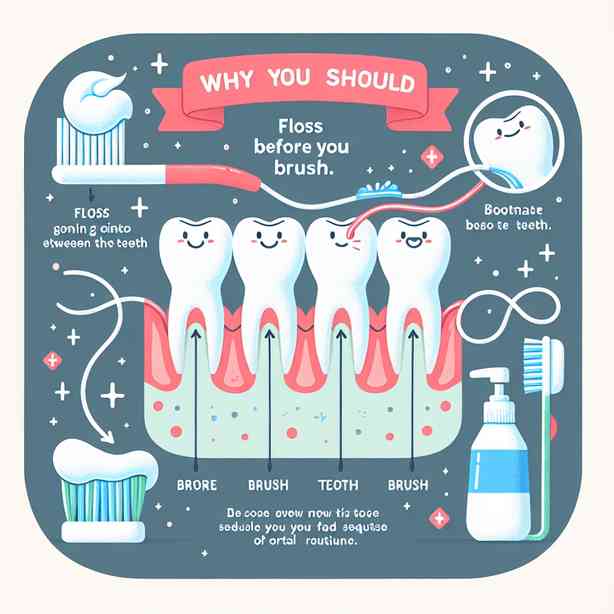
Flossing before brushing is a practice that many dental professionals advocate for, yet it often goes overlooked in our daily hygiene routines. The primary reason this sequence is recommended is that it allows for a more effective cleaning of the teeth, gums, and spaces between them. When you floss first, you remove food particles and plaque from the areas that toothbrush bristles often miss. This means that when you subsequently brush your teeth, the fluoride from the toothpaste can penetrate better into those clean spaces, enhancing its effectiveness.
Flossing helps in dislodging particles that accumulate between the teeth and along the gum line. If you brush before you floss, you might simply end up brushing around these particles, leaving them stuck in your mouth. Additionally, flossing first can act as a precursor to brushing by loosening plaque and debris, thus making the brushing process more effective. This practice encourages better oral hygiene and significantly lowers the risk of developing gum disease, cavities, and bad breath.
Health experts consistently emphasize the importance of maintaining healthy gums. Neglecting to floss can lead to the buildup of plaque, which can harden into tartar if not removed regularly. Tartar is more challenging to remove and requires professional cleaning. Hence, by flossing before brushing, you are not only removing food debris but also preventing tartar buildup, contributing to long-term oral health.
Moreover, flossing can enhance blood circulation in the gums. Improved circulation is crucial for maintaining healthy tissue and preventing gum disease. When you floss before brushing, you’re promoting dental health and encouraging the gums to heal from any potential inflammation. Healthy gums also provide a strong foundation for your teeth, making them less prone to sensitivity and decay.
Flossing also plays a vital role in combating bad breath. The particles that get trapped between teeth can contribute to unpleasant odors. By flossing first, you minimize the chances of bad breath by targeting the root of the problem. Once you remove these particles, brushing can then help eliminate remaining bacteria and freshen your breath.
Many individuals may find that flossing is an arduous task, leading them to skip it altogether or perform it improperly. However, developing a proper technique can transform this into a swift and manageable process. It’s essential to gently slide the floss between your teeth in a C-shape, making sure to cover both sides of each tooth. This method ensures that you’re effectively cleaning the surfaces that are often neglected. If you’re unsure how to floss correctly, seek guidance from your dentist or dental hygienist during your next visit.
Research supports the practice of flossing before brushing as a means to reduce plaque build-up and the risk of cavities. Studies indicate that individuals who incorporate both flossing and brushing into their daily routines experience fewer dental issues over time. The combination of these two practices leads to healthier teeth and gums, significantly impacting overall health. This connection between oral health and general well-being cannot be overstated; poor oral hygiene is linked to various systemic diseases, including heart disease and diabetes.
Implementing a consistent oral hygiene routine that includes flossing before brushing is a small change that can yield significant results. The effectiveness of your dental hygiene routine hinges on the sequence of these two vital practices. Over time, the habits established today will translate to long-term benefits for your dental health.
It’s also important to consider that dental hygiene involves not just brushing and flossing but also the regular visits to your dentist. Biannual check-ups allow your dental provider to monitor your oral health and address any issues before they escalate. Professional cleanings help remove tartar and provide a deep clean that at-home care cannot achieve. Combine this with your daily habits of brushing and flossing, and you create a comprehensive approach to oral health.
To fully leverage the benefits of flossing before brushing, consider utilizing products that make the process easier and more efficient. There are various types of floss, ranging from waxed to unwaxed, flavored to unflavored. Experiment with different options to find what works best for you, as the goal is to make the process enjoyable and effective. Additionally, flossing aids—like dental picks or water flossers—can be beneficial for those who struggle with traditional floss. Incorporating these elements into your routine can help ensure that flossing becomes a habit rather than a chore.
Lastly, don’t forget the importance of timing in your oral hygiene routine. Ideally, you should floss and brush twice a day, once in the morning after breakfast and once before bed. This regularity reinforces the beneficial effects of the routine, allowing your mouth to remain clean and healthy for longer periods.
In conclusion, the order in which you perform your dental hygiene routine has considerable implications for your oral health. Flossing before brushing not only enhances the effectiveness of your cleaning processes but also contributes to long-term dental health, reducing the risk of gum disease, cavities, and bad breath. Taking the time to floss first can ensure that you’re addressing plaque and debris in the hardest-to-reach areas of your mouth, allowing fluoride from your toothpaste to work its magic. As with any health-related behavior, establishing and maintaining a consistent routine can yield lifelong benefits, leading to a healthier smile and a healthier you. So, the next time you prepare to brush your teeth, remember the importance of flossing first – your mouth will thank you for it.


